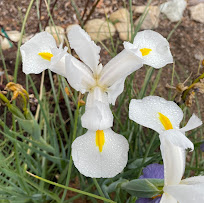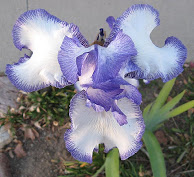The word “iris” is a Greek word pertaining to rainbows, because the flowers of this flower have many colors. “Iris” aptly describes also the various colors of the human eye. There is an iris in the eyes of most mammals and birds. The iris controls the diameter size of the pupil, which is the black dot = the eye’s aperture. It is also interesting to note that the very distinctive, three prominent petals of Iris flowers stand for “faith, wisdom, and valor.” As a final note, it is interesting that these flowers grow on very long stems.
The iris plant had its beginnings during a warm-climate time of middle Late Cretaceous time, about 80 million years ago. It possibly originated in what is now Turkey or Syria. The cultivation of Iris began with the early Egyptians.
It was introduced in the 1600s to North America via European settlers. Iris plants are hearty and require low maintenance (well-drained soil, appropriate amount of sunlight, etc.). They do well in many climates. Today, there are now between 200 and 300 species. Most are readily affordable from nurseries and have been by called by some gardeners as “a poor-mans’ orchid.” They grow from blubs and bloom in early spring to early summer. They have even bloomed as early as early February in sunny southern California.
Iris plants belong to family Iridacea and genus Iris.
The irises figured below are classified Iris x hollandica (a hybrid commonly known as the “Dutch Iris.”). The “Dutch Iris developed from species native to Portugal, Spain, and North Africa. Iris flowers can be any color (blue, purple, yellow, white, red—or any combination thereof). They nearly always have minor patches of another color (i.e., commonly yellow). Thus, white ones are not all white. Irises grow back each year because they are perennials. Nevertheless, some gardeners treat them as annuals (die off after a year), discarding the old plant and planting fresh bulbs each years.
Irises are toxic to cats and dogs, but the highest concentration of toxins is in the underground rhizomes of these plants.
Figure 1. Long-stemmed blue and yellow Iris, width of a single flower 5 inches.
Figure 2. From the cluster of flowers in previous image is a close-up view of a single Iris flower, width 5 inches.
Figure 3. Close-up view of a white Iris flower, width 5 inches (as well as a partial view of an adjacent flower).
Figure 4. Close-up view of a lavender, white, and yellow Iris flower, width 5.5 inches (as well as a partial view of an adjacent flower.
Figure 5. Close-up view of a blue and white Iris flower, width 4.5 inches. Note: this flower was photographed in an early version of my family’s garden, in 2014.
References Consulted
Waters, T. 2016. The evolution of irises. A blog article.
World of irises. [A blog of the American Iris Society]. https://the american iris society.blogspot.com/2016/the-evolution-of-irises.html
Another informative blog about Iris is: https://funny how flowers do that.co.uk





No comments:
Post a Comment